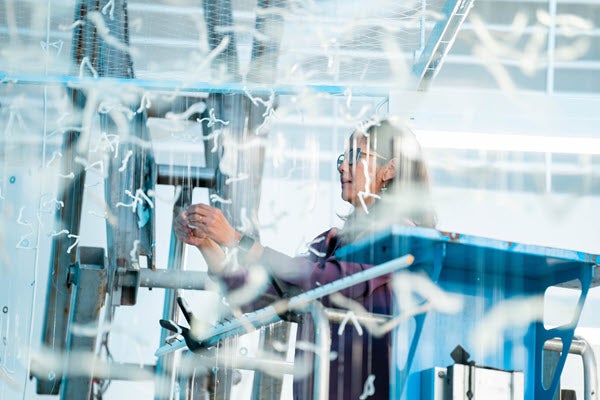The Moody Center for the Arts at Rice University seeks to enhance the student experience through transformative and meaningful encounters with the arts

One of several ways in which the Moody achieves this goal is through the Moody Project Wall. This program facilitates cross-campus engagement with an artist from Houston to create an original work of art installed inside the Moody. Previous projects have been led by Gerardo Rosales, Reginald C. Adams and Deborah D.E.E.P. Mouton.
The latest commission in this series, “Swarm Migration,” by Bennie Flores Ansell, is a multimedia installation centered on the experience of human migration. As a part of the process, Flores Ansell led multiple student workshops that focused on the overlooked histories of migration to Rice; the personal experience of migration and its impact on cultural identity; and the materials and methods employed in the artwork.
In collaboration with the artist, Rice student Marc Armeña ’24 conducted archival research at the Houston Asian American Archive on campus to illuminate the life story of Rudolfo Hulen Fernandez, Rice's first Asian American student from the Class of 1917. Additionally, with the Philippine student group, Anakbayan Rice, Flores Ansell led a writing workshop that collected narratives and drawings about student migration. Both images of Hulen Fernandez and the students’ stories were installed adjacent to the artwork.

As a part of the physical production of “Swarm Migration,” students were introduced to technologies used in the artwork, including 3D-printing and TouchDesigner software. Students toured the Moody’s Makerspace, where several of the 3D components were made.
Additionally, Billy Baccam and Alex Ramos of Input/Output worked with Flores Ansell and students in a generative design workshop to digitally simulate bird flight patterns that would inform the shape and placement of the artwork. Then, across a period of two weeks, students assisted with suspending over 1,000 3D-printed and ceramic wishbones, which formed an intricate design.
By punctuating the installation with workshops that tied historical exploration and personal reflection to material artmaking, Flores Ansell was able to show students how archival research and introspection fit into the artmaking process.
The community-building aspect of this project will continue for several months. Campus visitors and students submitted their own migration stories at the Moody until mid-April. Flores Ansell scanned the writings for a digital archive, and the paper was composted in a special Earth Day event April 22 at the Friedman Holistic Garden. Participants who submitted their stories will be able to return to the garden in early September to collect the plant growing from their personal narratives.
“In this way, our migration stories are integrated into the soil we all share,” said Molly Everett, assistant curator for the Moody Center for the Arts. “Through this process we are reminded of the generative power of co-creation.”
— Erin Rolfs
Director
Marketing and Communications
Moody Center for the Arts

